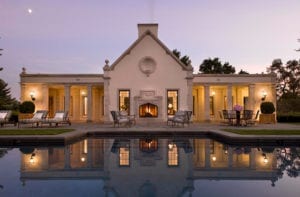A Return to Elegance
August 24, 2015
Thanks to the discerning eyes of one couple, a grand but worn-out old Back Bay townhouse once again exhibits its debonair character.
Text by Robert Kiener Photography by Richard Mandelkorn


Love at first sight” is how Boston investment manager Bob Atchinson describes his initial visit to the stately, five-story Commonwealth Avenue townhouse that he and his wife, Michelle, now call home. “It was magnificent and full of character. Although time had taken its toll, I knew it could be restored to its former glory.”
Architect Bob Paladino and designer Cynthia Deysher agreed. “The first time I saw it I realized it had great bones and great potential,” Paladino says. As Deysher recalls, “It was steeped in history and was so elegant. But it needed work.”
That’s putting it mildly. The townhouse, built in 1878 on land once owned by John Wilkes Booth, was showing more than a few signs of age. The building’s herringbone, quarter-sawn oak floors were scuffed and worn. Its ornate paneling and wainscoting needed repair and refinishing. Beautiful details like leaded windows, faux stone wainscoting, and elegant limestone fireplaces cried out for restoration. “This was a job that demanded skilled craftsmen’s attention to detail,” says Paladino.
Over its life, the 7,400-square-foot structure had undergone several transformations and many renovations. Originally a single home, it became a private club in 1940. The St. Botolph Club, an exclusive arts club founded in 1880, occupied the premises until 1972. The building was then sold and divided into seven apartments, which were reduced to five after a fire broke out in 2004. “Happily, a lot of the craftsmanship that went into the townhouse survived the transformations and the fire,” says Paladino.
The Atchinsons’ long-term plan included creating their own home on the two lower floors and converting the other three floors into living spaces for their grown children. “Everyone involved wanted the same thing: to restore this townhouse and make it look, and especially feel, like a home again,” Michelle says.
Despite its general state of disrepair, the townhouse showed plenty of evidence of the skill of the nineteenth-century craftsmen who built it. “All of us felt privileged to work on a vintage property like this,” says general contractor Ken Vona.
One of the biggest challenges he and his team faced was matching the new work to the original. “Our work had to blend in seamlessly with the nineteenth-century version,” he says.
No detail was overlooked. Restoring one face-nailed, inlaid, quarter-sawn oak floor required resetting tens of thousands of nails, filling in the nail holes, and resurfacing the floor. Plasterers painstakingly restored and replaced the wainscoting in several rooms. “It was time-consuming to fabricate new plaster molds and match the new work to the existing walls,” says Vona.
He and his subcontractors were challenged to add all the modern necessities—new electrical, audio wiring, and a high-tech alarm system—without making them obvious. “We wanted to make everything as invisible as possible,” says Vona. Automatic window shades are cleverly tucked away in millwork. The family room’s flat-screen television hides behind wood paneling. In every room, the new blends in perfectly with the old.
Thanks to its various reconfigurations over the years, the building’s interior was dark. “It seemed a bit gloomy when I first entered,” admits Michelle. To flood the space with natural light, Paladino enlarged a rooftop skylight and opened up a once-closed stairwell between the floors. “This gave us a light shaft that runs all the way through the building,” explains Deysher. “It helped make the entire house brighter and more airy.”
To soften an early-twentieth-century Gothic addition, the team redesigned the stairways, removing wrought-iron balustrades on several floors and replacing them with more-traditional wood banisters supported by white wooden spindles. “We did this to lighten the house and bring it back to its 1880s feel,” says Deysher.
To further lighten the look and feel, Deysher and Michelle chose a palette of pale blues, greens, and creams for the walls, fabrics, and furniture. Rugs and carpets in quiet neutral hues add softness. Deysher also added recessed ceiling lighting, wall sconces, chandeliers, and table lamps throughout the house. “At one time we even considered painting the rich dark paneling in the living room, but we decided against it,” the designer notes. “Cleaning it and reconditioning it lightened and softened it a lot.”
Simple, classic window treatments—and, in the case of the leaded windows, no treatments at all—make the most of the natural light that washes in from Commonwealth Avenue.
Scale was also an important consideration in the interior design. In the dining room, for example, Deysher specified oversize embroidered-silk dining chairs, a massive mirror, and a large rock-quartz crystal chandelier to stand up to the generous proportions of the limestone fireplace and fourteen-foot ceilings.
A new mural, by Mendon-based painter George Paicopoulos, that features historical scenes from nineteenth-century Boston wraps around the dining room walls and continues up the stairway. “We used old prints and engravings as the basis for the scenes we included in the mural,” explains Deysher.
Bob Atchinson admits they took “a small liberty” with the mural’s historical accuracy. The artist included an image of Bob and Michelle, dressed in nineteenth-century garb and riding in a horse-drawn carriage down Commonwealth Avenue. When the couple’s grandchild was born during the renovation, the artist added him in a pram being pushed by the Atchinsons’ daughter and son-in-law.
Bob and Michelle report that they are so thrilled with the way their two-floor home turned out, they are now restoring the two floors above for their daughter and her family. “Everyone involved with this project really went above and beyond to preserve the details that make this house so special,” says Bob. Recently, the couple showed off the completed renovation to members of the St. Botolph Club and got their wholehearted seal of approval. “They told us they were happy we saved and restored so much of the craftsmanship that went into this house,” Bob Atchinson says. “We feel the same way; once again this historic house is a home.” •
Architecture: Robert (Bob) Paladino, Mellowes & Paladino Architects
Interior design: Cynthia Deysher, Deysher Advisory Services
Builder: Ken Vona, Kenneth Vona Construction
Share
![NEH-Logo_Black[1] NEH-Logo_Black[1]](https://www.nehomemag.com/wp-content/uploads/2022/08/NEH-Logo_Black1-300x162.jpg)















You must be logged in to post a comment.